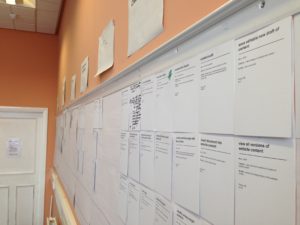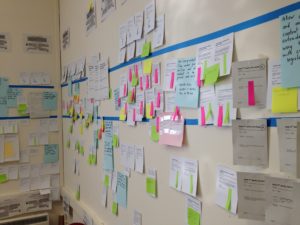We love our story map
What do you do with 300 user stories instead of a huge business requirements document? How do you put them into some sort of order? Where do you start?
The problem with being agile
Agile development methodology is great but for big projects it can present a few problems of its own. Agile is what we are using to build the new Drupal CMS. It consists of intense development cycles or iterations.
And instead of writing a huge business requirements document that you lob over the fence to the developers and get on with your day job, you gather together user stories.
These are discrete blocks of software functionality written by the users of the system. It helps the business get exactly what they want by encouraging constant communication and adjustments to the product during the development phases.
For an agile project you need to present the stories in priority order so that the top ones are guaranteed to be delivered. No time is wasted by getting bogged down in functionality that is nice to have but not essential.
Making agile work for a large-scale project
This is where you can really struggle in an agile project that is so big and complex: With 300 separate stories in a spreadsheet how can you group these into a coherent unit? One that you can all comprehend and discuss. 300 stories is just too big to keep in your head at the same time.
Mapping our stories
While we were struggling with this issue one of the developers turned up an article from Smashing Magazine – ‘Fitting the big picture UX into Agile’. It led to the whole team spending two whole days with a huge stack of cards and a big blank wall. Each of the cards had one user story printed on it and the aim was to get all the cards up on to the wall in some sort of logical pattern.
We’d already classified most of the stories into themes and managed to prioritise them loosely into must haves, should haves and could haves. We’d already discarded those that just weren’t going to make the grade.
We stuck the cards up onto the wall, grouped into their themes and layered with their priority. The higher the card on the wall the higher the priority. And suddenly everything started to click into place. We had something that we could all see. A focal point we could use to lead and shape our discussions. We finally had our big picture.
It’s very much a work in progress and lives and breathes on the wall in our office.




2 replies to “We love our story map”